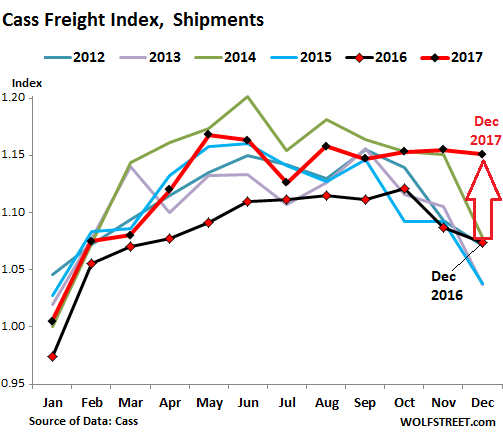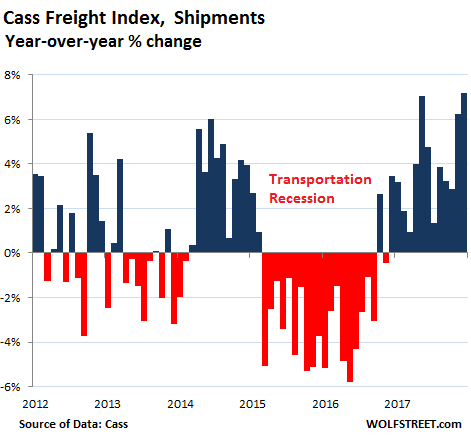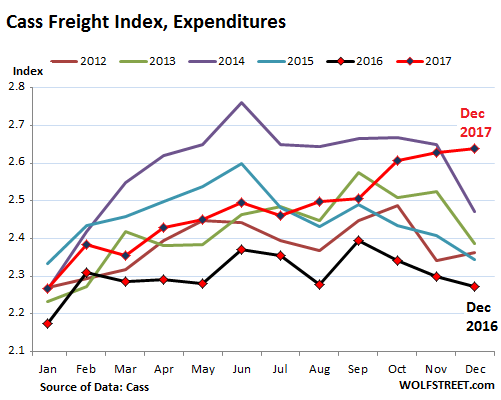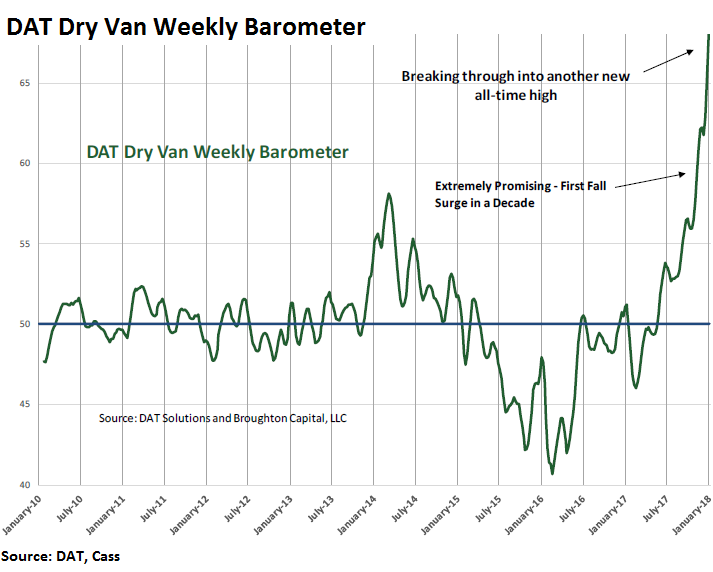Transportation Recession of 2015 and 2016 is just an Ugly Memory.
The transportation recession of 2015 and 2016 has receded into memory, and the trucking industry is hopping and railroads are getting their share, rates are surging, and so are costs, and the money is flowing. The Cass Freight Index, which tracks US shipment volumes by all modes of transportation, rose 7.2% year-over-year in December, to the highest level for any December since 2007.
The Cass Freight Index is not seasonally adjusted, with peaks in early summer for back-to-school season and in September during shipping season ahead of the holiday sales season. December marks the end of shipping season, and shipments normally plunge from November. But in December 2017, instead of plunging, shipments barely edged down from November. In the chart, the difference between 2017 (red line with black markers) and 2016 (black line with red markers) shows the severity of the transportation recession and the powerful recovery since:

The green line in the chart above represents 2014, which had been a banner year for US transportation until it began to unravel at the end of 2014 and descended into the full-blown transportation recession covering much of 2015 and 2016.
The index is based on “more than $20 billion” in annual freight transactions, according to Cass Information Systems. It does not cover bulk commodities, such as oil and coal but is focused on consumer packaged goods, food, automotive, chemical, OEM, and heavy equipment, shipped via truck, rail, barge, and air.
The chart below of year-over-year percentage changes in the Cass Freight Index for shipments shows the severity of the transportation recession in 2015 and 2016 — which I covered, including in May 2016, with Freight Rail Traffic Plunges: Haunting Pictures of Transportation Recession. The chart also shows just how powerful the recovery has been:

The e-commerce boom gets part of the credit, with e-commerce sales surging 15.5% in the third quarter of 2017, according to the Commerce Department, and 18% over the holiday period, according to Adobe. Cass: “Data continues to suggest that the consumer is finally starting to spend a little, albeit not with brick and mortar retailers.”
The report also pointed out that, with the transportation recession over, “freight seems to be gaining momentum in most segments.” It cites the DAT Dry Van Weekly Barometer – tracking the dynamics of van trailers hauled by Class 8 semi-trucks – which “is giving us real‐time indications of stronger demand and tighter capacity in this key freight group.” (Click to enlarge):
With shipping volumes rising, and shipping rates rising on top of it, the amount spent on shipping has surged. The Cass Expenditure Index, which tracks the amounts spent on freight for all modes of transportation, soared 16% year-over-year in December (2.638), the highest in the data series going back to 1999.
The chart below shows how spending on freight in 2017 (red line with black markers) has risen throughout the year, even blowing by the normal seasonal decline in December, to produce the strongest December in the data series going back to 1999, while freight spending in 2016 – the black line with red markers at the bottom – had been mired in the ugly transportation recession:

“December’s 16.0% increase clearly signals that capacity is tight, demand is strong, and shippers are willing to pay up for services to get goods picked up and delivered in modes throughout the transportation industry,” the report explains.
Fuel prices have surged too, “up as much as 75%” on a year-over-year basis. Fuel surcharges are included in the Expenditures Index. But the report points out that the year-over-year increase in spending “attributable to fuel is now diminishing.” And Cass is “seeing some improvements in the pricing power of truckers and intermodal shippers.”
The increased costs of shipping are either filtering into the prices of goods and into consumer price inflation, or, if they cannot be passed on directly or indirectly, they are absorbed by the companies paying for them. With e-commerce rocking and rolling and with many other parts of the economy tagging along – the auto sector being one of the exceptions – the transportation sector is for now scrambling to meet demand.
Brick-and-mortar retailers have been in full meltdown for the past two years. Many of them were owned PE firms that have doomed them. Here they are…. The Private Equity Firms at the Core of Brick & Mortar Retail Bankruptcies
Enjoy reading WOLF STREET and want to support it? You can donate. I appreciate it immensely. Click on the mug to find out how:
![]()



But..but…the Fed and our Soviet-style CPI numbers assure us there is no inflation.
True enough – the Fed has learned, no matter how high inflation goes, they can simply lie and say there is no inflation – they never seem to get called on their B.S.
I’m experiencing out of control inflation. I live in a van because my wages ($93K/year) are insufficient to rent an apartment – yet somehow the Fed says inflation is not high enough!
My life savings is now all but worthless. Inflation has been out of control for 10 years and the Fed is still holding interest rates under 1.5% – WTF!
Well… I will admit the banks are sure doing great these days.
What kind of apartment are you looking for? I find this hard to believe.
Wolf,
It was a great season for freight but I notice you didn’t mention the official start of the elog requirement in December.
How much do you attribute that to the surging rates?
I used to work in the industry and the amount of guys who would run with multiple log books would shock you.
Actually, DAT reported in the past couple of weeks that van rates have started to edge down. So I’m not sure if the elog impact is clearly visible in December. The fact that this would happen has been known for a long time, giving everyone time to prepare, which might have contributed to the higher rates in prior months. And there are many other factors involved too.
This data seems to fit with recent drops in the savings rate. Stock and RE are up, and this gives people the illusion of wealth, even if their income hasn’t changed. However, what happens if the stocks and RE drop and the phantom wealth disappears? Consumers are left with the additional debt and no income to show for it.
As the savings rate declines, fewer and fewer people have the capacity to buy anything.
This little uptick in economic activity may be the last hurrah. The low savings rate is not sustainable.
Why would the Fed allow stock and RE markets to drop? Consumers need not worry about their debts – the Fed is paying off those debts with rampant inflationary policy.
If you could go back ten years and tell someone living in Seattle that an 800 square foot dump in Ballard would sell for over $1 million and that the Fed is holding interest rates at emergency levels of less then 1.5%, because they claim there is no inflation, that person would not think it possible.
The reckless disregard for confidence in the dollar is shocking. I’m losing my motivation to work – I can’t even afford shelter. The Fed wonders why the labor participation rate is so low. Should people really want to work just to earn dollars – those don’t buy much these days.
The economy has been humming along here in Central Florida for a couple of years now. Traffic continues to get worse, because folks are out doing stuff. RE prices are coming out of the slump and moving up quickly. A friend of mine in his mid-50’s just got a job after 5 years out of work with SpaceX.
Most folks I’m talking to are actually seeing modest pay increases. However, I think people are still stuck in the mindset of the ’80’s and ’90’s. We’ve outsourced our industry. Middle-middle class jobs are gone and aren’t coming back. From now on, we’re going to be a country where 75% live week to week and 25% live really pretty well. I think the economy is doing really well, at least around here. And at least for what it can be.
Have to agree with what you say. I’ve said since ’08 that this economy will resemble Mexico’s economy in a few years. A few that have opulent wealth and a great many that do not have much of anything. It’s coming to fruition and one crash of the markets is all it will take to realize it.
There’s just so much “non-conformity” with this 10-year-old prediction that the best way to proceed is probably to wait another 10 (or maybe 100?) years….
“I’ve said since ’08 that this economy will resemble Mexico’s economy in a few years”
Well, Mexico is in the process of annexing California so, yeah.
Mexico is in the process of having drug cartels completely take over their oil industry. USA better pull our heads out of our rear ends. Mexico as a country has become completely compromised. The drug cartels are turning into a conglomerate that will eventually in my lifetime turn into a very formidable fighting force. I could see my kids generation having to go to all out war with the cartels to not only preserve our borders but to preserve the country of Mexico as a nation state.
I hear Mexicans can still afford shelter and healthcare in their country. Might be a good idea to flee to Mexico before the wall goes up and it gets harder to sneak out of the U.S. I’m not worried though, they won’t build the wall over the Pacific ocean so I’m certain I will be able to sneak out of here on a raft or a dingy.
Ya empezo aprender Espanol, yo sere listo cuando llega el dia.
This is a mixed bag of a good economy along with many drivers retiring or can no longer qualify for a commercial license due to new requirements of a birth certificate or a passport to renew or apply for a commercial license. Another problem we are now facing is electronic log books, productivity is down and drivers hate them for many reasons, some are just retiring or off to another line of work. My guess is companies like Qualcomm worked Washington hard with lobbyist to get this thru.
Driver pay is still not where it belongs and hopefully the wages will rise and is long over due.
“Driver pay is still not where it belongs and hopefully the wages will rise”
I would expect pay to be lower for jobs that many can do and will soon (a decade?) be largely automated. And if not having a US birth certificate or passport is preventing non-citizens from trucking – isn’t that the goal of such laws, and a valid one at that? And doesn’t that drive up wages, which you were just saying are too low?
The passport birth certificate is a new requirement by the Fed’s, I am sure Calif would never enforce this if they did not have to, I personally think it’s great and long over due.
I do oversize overweight heavy haul so I am not concerned of automated trucks. With electronic logs books the drivers are not getting in the miles or hours they use to so they want to be compensated. Compared to Police or city jobs yes they are underpaid.
Cops and city employees are extremely overpaid and have extravagant benefits paid for by taxpayers. They are part of the problem, not something to aspire to.
The holiday season is now extended well into January because of gift cards. The discounts used to be huge after Xmas but not anymore. People are still using the gift cards for the next few weeks.
Prices are definitely up, yesterday I saw a nice set of dishes in the thrift store for $150, the sign said “Don’t ask for discount.”
This is part and parcel of the “trickle down” economy, only not wealth flow but inflation. The vast majority of which will be passed on to the end user, the consumer. Who does not have the level of discretionary spending as savings, but only that of higher debt loads.
This goes hand-in-hand with the markets blow off tops, currently being witnessed. Evidenced by the historic highs reached by the S&P 500 where it set three new records simultaneously:
1. Never been this over-valued before
2. Never been this over-bought before
3. Never gone this long without a minor (5%) correction
As for rail loads recovering, 33 miles south east of Tucson, there are over 300 engines sitting idle. Nationwide about 1,400 Union Pacific engines sit in various staging areas. Many other railroad staging areas contain massive amounts of idle rolling stock.
“We’re waiting for demand to meet supply”, said Union Pacific spokesman J. Jacobs.
During blow off topping events, its not only the stock markets that experience this. Everyone seems to have feelings of irrational exuberance.
Also, it now takes the average wage earner 130 hours to earn enough to buy one share of the S&P 500 – the average since the start of the index was about 40 hours of work to buy one share (130 hours blew way, way past the previous record). Yet the S&P returns near a record low yield (this despite borrowing record amounts to pay dividends). Bernanke thought this scheme was a great idea – and now he’s collecting his reward earning a fat paycheck for a figurehead job at a hedge fund – quid pro quo.
Everyone feeling wealthy? Go out and buy a new house and a truck (fully loaded) – that Ben is a genius, don’t ya know.
BTW I love Tucson – I wish I could find a decent job there and escape the S-hole I’m living in (Seattle – this place is the worst).
Just another indicator – along with business sentiment, capex, industrial production, oil prices, etc. – that is saying: BOOM! About time. Not many people remember what it feels like. Been a long time.
If this is a boom then I prefer the bust. At least during the “bust” I could afford a place to live. Don’t forget, most of us did not lose our jobs during the “bust” and for most of us the cure has been worse then the disease.
And they keep saying muppets have no money.
Been saying in many threads that Americans, Europeans, etc, etc have more money than they say they have. You can take that to the bank.
It’s obvious they just needed Trump to unleash it.
The repeal of the individual mandate in Obamacare has unleashed some cash for those who dropped the coverage. We know a couple of single guys who were paying at least $700+ a month who dropped it. One has a brand new truck.
The individual mandate is still in effect for 2018. Your friends will likely be hit with the tax penalty:
“The individual mandate, which requires most Americans (other than those who qualify for a hardship exemption) to carry a minimum level of health coverage, is actually still in effect for 2018—meaning that you may have to pay a steep tax fine if you don’t have health insurance, for one thing.”
Source:
http://fortune.com/2017/12/20/tax-bill-individual-mandate-obamacare/
Oh, well. They were both counting on the tax cut and repeal of the mandate to put some cash in their pockets.
They are foolish The everything bubble is about to be burst by various factors including much higher oil prices If they were smart they would be hunkering down for the coming storm
IMO these measurements – freight activity, dry goods indexes, etc are helpful in indicating the true state of the economy for us “Little People” non-elites. There may indeed be some genuine unplanned growth escaping into economy after years of Obama’s calculated anti-growth policies of devastating bone crushing austerity. The $70,000 question is how will it impact interest rates?
And let that be a lesson.
What about the 90-100 million people that are available for work and 40 million still on food stamps. Is the economy really coming back?
Those people are, in effect, surplus to requirements for the purposes of the economy.
Moreover, they remain consumers, whether in or out of work, on food stamps, etc
A Recovery in which a great many suffer or are under-utilized is perfectly conceivable. In fact, here it is…..
Can confirm: California highways and freeways are clogged with big rigs every weekday/night. Weekends are only a little better.
I think this article is as close Wolf will ever get to possibly suggesting to his readership that the much criticized recovery is real and that stocks are a good buy.
Dow $TRAN is off the charts compared to 2007!
https://www.barchart.com/stocks/quotes/$TRAN/interactive-chart
This is weird. I don’t usually read good news stories and upbeat comments on this site. Were all the bears carried out on stretchers with the S&P 500 up 24.68% year over year ?
I remember in 2010 Jack Bogle saying to stay fully invested in stocks and bonds AND ignore both good news and bad news. Seven years later, he was proven right.
Must be because more and more people are buying online and no longer going into stores to purchase items. It’s easier to buy straight from a manufacturer or even a website like Amazon/Alibaba. With this, it leads to more shipping going out to make sure the products get to the customers. Don’t forget eCommerce websites that either drop-ship or carry inventory.
Would this be a leading or concurrent or lagging indicator? Sort think, that like wages, it my be a lagging indicator. But I could see arguments going the other way.
The AIA (Architect Billing) is a leading indicator of construction, but since construction is a (heavily) lagging indicator, I take it to be something of a lagging indicator. When its really up (like it is now), your business cycle is getting a bit ripe.
I’m thinking your transportation index might be indicating the same thing.